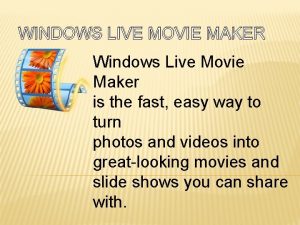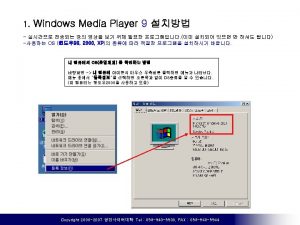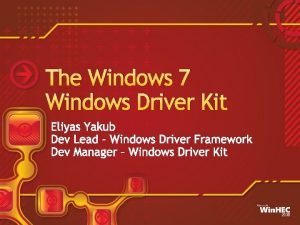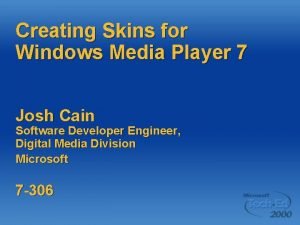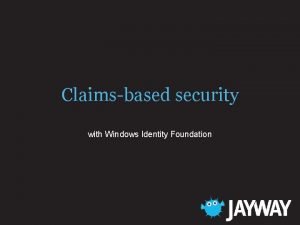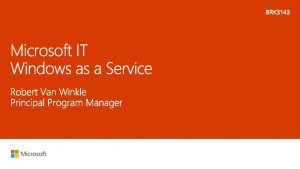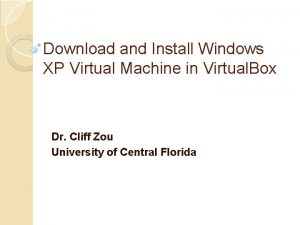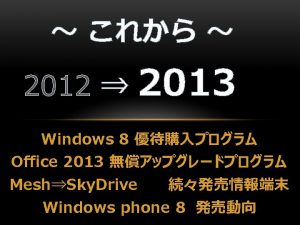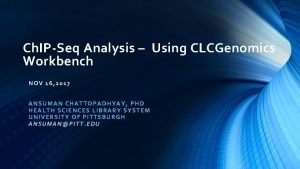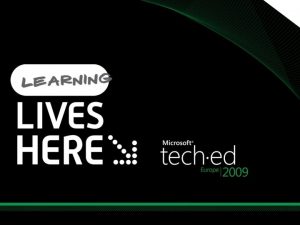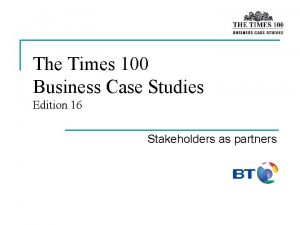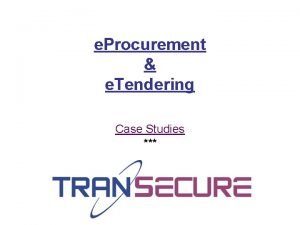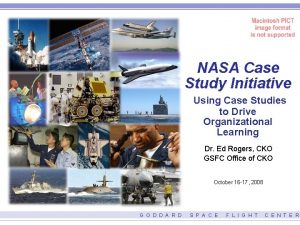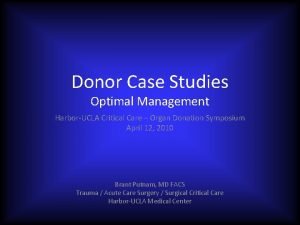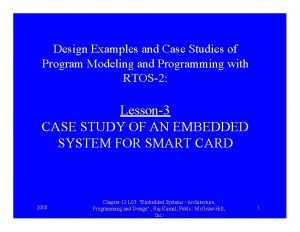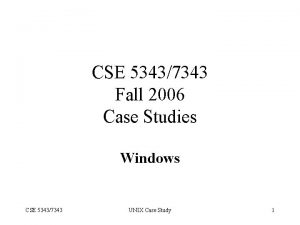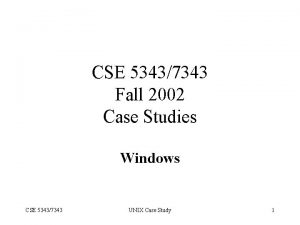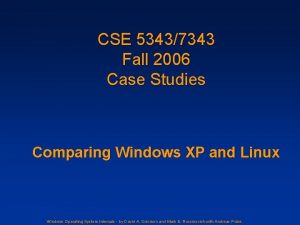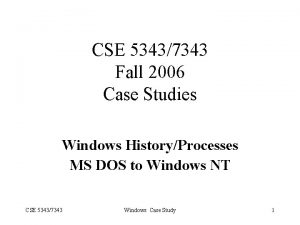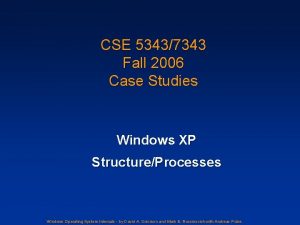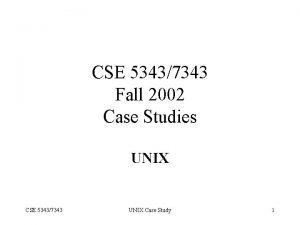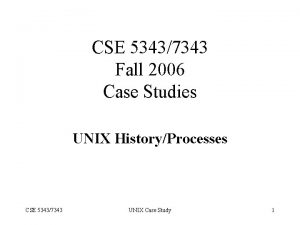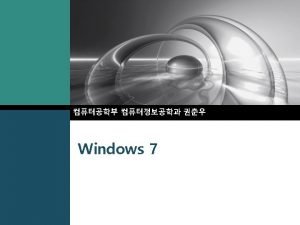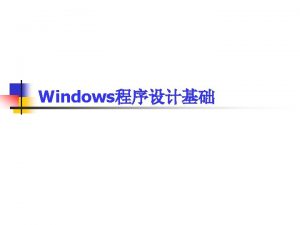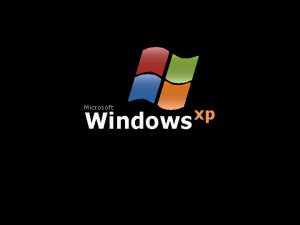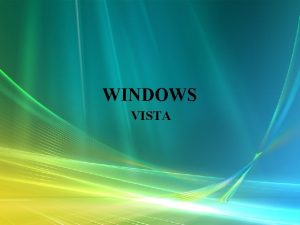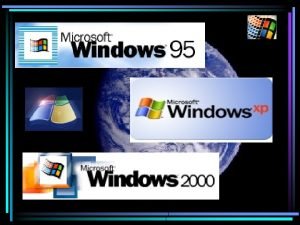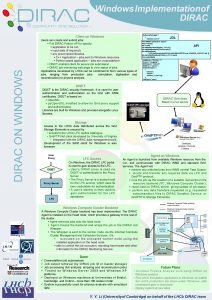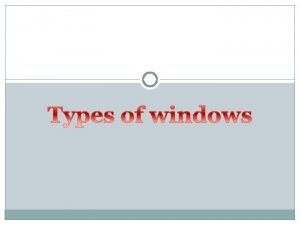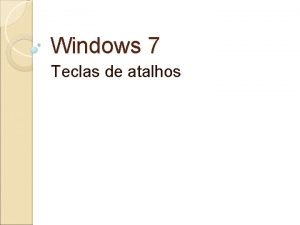CSE 53437343 Fall 2006 Case Studies Windows XP




































- Slides: 36

CSE 5343/7343 Fall 2006 Case Studies Windows XP Structure/Processes Windows Operating System Internals - by David A. Solomon and Mark E. Russinovich with Andreas Polze

Copyright Notice © 2000 -2005 David A. Solomon and Mark Russinovich These materials are part of the Windows Operating System Internals Curriculum Development Kit, developed by David A. Solomon and Mark E. Russinovich with Andreas Polze Microsoft has licensed these materials from David Solomon Expert Seminars, Inc. for distribution to academic organizations solely for use in academic environments (and not for commercial use) 2

Roadmap for Section 2. 1. Architecture Overview Program Execution Environment Kernel Mode Architecture System Threads System Processes / Services 3

Simplified OS Architecture System support processes User Mode Service processes User Environment applications subsystems Subsystem DLLs Kernel Mode Executive Kernel Device drivers Windowing and graphics Hardware Abstraction Layer (HAL) 4

OS Architecture Multiple personality OS design user applications don't call the native Windows operating system services directly Subsystem DLLs is to translate a documented function into the appropriate internal (and undocumented) Windows system service calls. Environment subsystem processes Manage client processes in their world Impose semantics such as process model, security Originally three environment subsystems: Windows, POSIX, and OS/2 Windows 2000 only included Windows and POSIX Windows XP only includes Windows Enhanced POSIX subsystem available with Services for Unix Included with Windows Server 2003 R 2 5

Kernel-Mode Components: Core OS Executive base operating system services, memory management, process and thread management, security, I/O, interprocess communication. Kernel low-level operating system functions, thread scheduling, interrupt and exception dispatching, multiprocessor synchronization. provides a set of routines and basic objects that the rest of the executive uses to implement higher-level constructs. Both contained in file Ntoskrnl. exe 6

Kernel-Mode Components: Drivers Device drivers (*. sys) hardware device drivers translate user I/O function calls into specific hardware device I/O requests virtual devices - system volumes and network protocols Windowing and Graphics Driver (Win 32 k. sys) graphical user interface (GUI) functions (USER and GDI) windows, user interface controls, and drawing Hardware Abstraction Layer (Hal. dll) isolates the kernel, device drivers, and executive from hardware Hides platform-specific hardware differences (motherboards) 7

Background System Processes Core system processes, logon process, the session manager, etc. not started by the service control manager Service processes Host Windows services i. e. ; Task Scheduler and Spooler services Many Windows server applications, such as Microsoft SQL Server and Microsoft Exchange Server, also include components that run as services. 8

Portability When Windows NT was designed, there was no dominant processor architecture Therefore it was designed to be portable How achieved? Most Windows OS code and device drivers is written in C HAL and kernel contain some assembly language Some components are written in C++: windowing/graphics subsystem driver volume manager Hardware-specific code is isolated in low level layers of the OS (such as Kernel and the HAL) Provides portable interface NT 4. 0 had support for x 86, MIPS, Power. PC, Digital Alpha AXP Power. PC and MIPS dropped soon after NT 4 release Alpha AXP dropped in 1999 (supported through SP 6) 9

Reentrant and Asynchronous Operation Windows kernel is fully reentrant Kernel functions can be invoked by multiple threads simultaneously No serialization of user threads when performing system calls I/O system works fully asynchronously Asynchronous I/O improves application’s throughput Synchronous wrapper functions provide ease-ofprogramming 10

Key Windows System Files Core OS components: NTOSKRNL. EXE** Executive and kernel HAL. DLL Hardware abstraction layer NTDLL. DLL Internal support functions and system service dispatch stubs to executive functions Core system processes: SMSS. EXE Session manager process WINLOGON. EXE Logon process SERVICES. EXE Service controller process LSASS. EXE Local Security Authority Subsystem Windowing subsystem: CSRSS. EXE* Windows subsystem process WIN 32 K. SYS USER and GDI kernel-mode components KERNEL 32/USER 32/GDI 32. DLL Windows subsystem DLLs 11

Key System Components Environment Subsystems User Mode System & Service Processes User Application Subsystem DLL Kernel Mode OS/2 Windows Executive Device Drivers Hardware Abstraction Layer (HAL) POSIX Kernel Windows User/GDI Device Driver 12

Memory Protection Model No user process can touch another user process address space (without first opening a handle to the process, which means passing through Windows security) Separate process page tables prevent this “Current” page table changed on context switch from a thread in 1 process to a thread in another process No user process can touch kernel memory Page protection in process page tables prevent this OS pages only accessible from “kernel mode” x 86: Ring 0, Itanium: Privilege Level 0 Threads change from user to kernel mode and back (via a secure interface) to execute kernel code Does not affect scheduling (not a context switch) 13

32 -bit x 86 Address Space 32 -bits = 4 GB Default 2 GB User process space 2 GB System Space 3 GB user space 3 GB User process space 1 GB System Space 14

Kernel-Mode vs User-Mode Quick. Slice (qslice. exe) Fastest way to find CPU hogs Red=Kernel, Blue=User mode Double-click on a process to see a per-thread display for that process Sum of threads’ bars for a process represents all of the process’s time, not all CPU time Screen snapshot from: Resource Kit | Quck. Slice 15

Task Manager: Processes vs Applications Tabs Processes tab: List of processes Applications tab: List of top level visible windows Right-click on a window and select “Go to process” “Running” means waiting for window messages 16

Windows Architecture System Processes Services Environment Subsystems Applications Service Control Mgr. Svc. Host. Exe LSASS Win. Mgt. Exe Win. Logon User Mode Explorer Spool. Sv. Exe OS/2 User Application Services. Exe Session Manager Windows Task Manager POSIX Subsystem DLLs Windows DLLs NTDLL. DLL System Threads Kernel Mode System Service Dispatcher Windows USER, GDI (kernel mode callable interfaces) I/O Mgr Local Procedure Call Configuration Mgr (registry) Processes & Threads Virtual Memory Security Reference Monitor Power Mgr. Plug and Play Mgr. Object Mgr. File System Cache Device & File Sys. Drivers Graphics Drivers Kernel Hardware Abstraction Layer (HAL) hardware interfaces (buses, I/O devices, interrupts, interval timers, DMA, memory cache control, etc. ) Original copyright by Microsoft Corporation. Used by permission. 17

Microkernel OS? Is Windows a microkernel-based OS? No – not using the academic definition (OS components and drivers run in their own private address spaces, layered on a primitive microkernel) All kernel components live in a common shared address space Therefore no protection between OS and drivers Why not pure microkernel? Performance – separate address spaces would mean context switching to call basic OS services Most other commercial OSs (Unix, Linux, VMS etc. ) have the same design But it does have some attributes of a microkernel OS OS personalities running in user space as separate processes Kernel-mode components don't reach into one another’s data structures Use formal interfaces to pass parameters and access and/or modify data structures Therefore the term “modified microkernel” 18

Executive Upper layer of the operating system Provides “generic operating system” functions (“services”) Process Manager Object Manager Cache Manager LPC (local procedure call) Facility Configuration Manager Memory Manager Security Reference Monitor I/O Manager Power Manager Plug-and-Play Manager Almost completely portable C code Runs in kernel (“privileged”, ring 0) mode Most interfaces to executive services not documented 19

Kernel Lower layers of the operating system Implements processor-dependent functions (x 86 vs. Itanium etc. ) Also implements many processor-independent functions that are closely associated with processor-dependent functions Main services Thread waiting, scheduling & context switching Exception and interrupt dispatching Operating system synchronization primitives (different for MP vs. UP) A few of these are exposed to user mode Not a classic “microkernel” shares address space with rest of kernel-mode components 20

HAL - Hardware Abstraction Layer Responsible for a small part of “hardware abstraction” Components on the motherboard not handled by drivers System timers, Cache coherency, and flushing SMP support, Hardware interrupt priorities Subroutine library for the kernel & device drivers Isolates Kernel and Executive from platform-specific details Presents uniform model of I/O hardware interface to drivers Reduced role as of Windows 2000 Bus support moved to bus drivers Majority of HALs are vendor-independent HAL also implements some functions that appear to be in the Executive and Kernel Selected at installation time See windowsrepairsetup. log to find out which one Can select manually at boot time with /HAL= in boot. ini Sample HAL routines: Hal. Get. Interrupt. Vector Hal. Get. Adapter WRITE_PORT_UCHAR HAL kit Special kit only for vendors that must write custom HALs (requires approval from Microsoft) see http: //www. microsoft. com/whdc/ddk/HALkit/default. mspx 21

Kernel-Mode Device Drivers Separate loadable modules (drivername. SYS) Linked like. EXEs Typically linked against NTOSKRNL. EXE and HAL. DLL Only one version of each driver binary for both uniprocessor (UP) and multiprocessor (MP) systems… … but drivers call routines in the kernel that behave differently for UP vs. MP Versions Defined in registry Same area as Windows services (t. b. d. ) - differentiated by Type value Several types: “ordinary”, file system, NDIS miniport, SCSI miniport (linked against port drivers), bus drivers More information in I/O subsystem section To view loaded drivers, run drivers. exe Also see list at end of output from pstat. exe – includes addresses of each driver To update & control: System properties->Hardware Tab->Device Manager Computer Management->Software Environment->Drivers 22

Processes and Threads Per-process address space What is a process? Represents an instance of a running program you create a process to run a program Thread starting an application creates a process Process defined by: Address space Thread Resources (e. g. open handles) Security profile (token) What is a thread? An execution context within a process Thread Unit of scheduling (threads run, processes don’t run) All threads in a process share the same per-process address space Services provided so that threads can synchronize access to shared resources (critical sections, mutexes, events, semaphores) All threads in the system are scheduled as peers to all others, without regard to their “parent” process System calls Primary argument to Create. Process is image file name (or command line) Primary argument to Create. Thread is a function entry point address Systemwide Address Space 23

System Threads Functions in OS and some drivers that need to run as real threads E. g. , need to run concurrently with other system activity, wait on timers, perform background “housekeeping” work Always run in kernel mode Not non-preemptible (unless they raise IRQL to 2 or above) For details, see DDK documentation on Ps. Create. System. Thread What process do they appear in? “System” process (NT 4: PID 2, W 2 K: PID 8, XP: PID 4) In Windows 2000 & later, windowing system threads (from Win 32 k. sys) appear in “csrss. exe” (Windows subsystem process) 24

Examples of System Threads Memory Manager Modified Page Writer for mapped files Modified Page Writer for paging files Balance Set Manager Swapper (kernel stack, working sets) Zero page thread (thread 0, priority 0) Security Reference Monitor Command Server Thread Network Redirector and Server Worker Threads created by drivers for their exclusive use Examples: Floppy driver, parallel port driver Pool of Executive Worker Threads Used by drivers, file systems, … Work queued using Ex. Queue. Work. Item System thread (Exp. Worker. Thread. Balance. Manager) manages pool 25

Identifying System Threads: Process Explorer With Process Explorer: Double click on System process Go to Threads tab – sort by CPU time As explained before, threads run between clock ticks (or at high IRQL) and thus don’t appear to run Sort by context switch delta column 26

Process-Based Windows Code: System Startup Processes First two processes aren’t real processes not running a user mode. EXE no user-mode address space different utilities report them with different names data structures for these processes (and their initial threads) are “pre-created” in Ntos. Krnl. Exe and loaded along with the code (Idle) Process id 0 Part of the loaded system image Home for idle thread(s) (not a real process nor real threads) Called “System Process” in many displays (System) Process id 2 (8 in Windows 2000; 4 in XP) Part of the loaded system image Home for kernel-defined threads (not a real process) Thread 0 (routine name Phase 1 Initialization) launches the first “real” process, running smss. exe. . . and then becomes the zero page thread 27

Process-Based Windows Code: System Startup Processes (cont. ) smss. exe Session Manager The first “created” process Takes parameters from HKEY_LOCAL_MACHINESystemCurrent. Control. Set ControlSession Manager Launches required subsystems (csrss) and then winlogon csrss. exe Windows subsystem winlogon. exe Logon process: Launches services. exe & lsass. exe; presents first login prompt When someone logs in, launches apps in SoftwareMicrosoftWindows NTWin. LogonUserinit services. exe Service Controller; also, home for many Windows-supplied services Starts processes for services not part of services. exe (driven by RegistryMachineSystemCurrent. Control. SetServices ) lsass. exe Local Security Authentication Server userinit. exe Started after logon; starts Explorer. exe (see SoftwareMicrosoftWindows NTCurrent. VersionWin. LogonShell) and exits (hence Explorer appears to be an orphan) explorer. exe and its children are the creators of all interactive apps 28

Where are Services Defined? Defined in the registry: HKEY_LOCAL_MACHINESYSTEMCurrent. Control. SetServices one key per installed service Mandatory information kept on each service: Type of service (Windows, Driver, . . . ) Imagename of service. EXE Note: some. EXEs contain more than one service Start type (automatic, manual, or disabled) Optional information: Display Name New in W 2 K: Description Dependencies Account & password to run under Can store application-specific configuration parameters “Parameters” subkey under service key 29

Life of a Service Install time Setup application tells Service Controller about the service Registry Setup Application Create. Service System boot/initialization SCM reads registry, starts services as directed Management/maintenance Control panel can start and stop services and change startup parameters Service Controller/ Manager (Services. Exe) Service Processes Control Panel 30

Process Explorer: Service Information Process Explorer identifies Service Processes Click on Options->Highlight Services 31

Service Processes A process created & managed by the Service Control Manager (Services. exe) Similar in concept to Unix daemon processes Typically configured to start at boot time (if started while logged on, survive logoff) Typically do not interact with the desktop Note: Prior to Windows 2000 this was the only way to start a process on a remote machine Now you can do it with WMI 32

Mapping Services to Service Processes Tlist /S (Debugging Tools) or Tasklist /svc (XP/2003) list internal name of services inside service processes Process Explorer shows more: external display name and description 33

Service Control Tools Net start/stop – local system only Sc. exe (built in to XP/2003; also in Win 2000 Resource Kit) Command line interface to all service control/configuration functions Works on local or remote systems Psservice (Sysinternals) – similar to SC Other tools in Resource Kit Instsrv. exe – install/remove services (command line) Srvinstw. exe – install/remove services (GUI) Why are service creation tools included in Reskit? Because Reskit comes with several services that are not installed as services when you install the Reskit 34

Services Infrastructure Windows 2000 introduced generic Svchost. exe Groups services into fewer processes Improves system startup time Conserves system virtual memory Not user-configurable as to which services go in which processes 3 rd parties cannot add services to Svchost. exe processes Windows XP/2003 have more Svchost processes due to two new less privileged accounts for built-in services LOCAL SERVICE, NETWORK SERVICE Less rights than SYSTEM account Reduces possibility of damage if system compromised On XP/2003, four Svchost processes (at least): SYSTEM (2 nd instance – for RPC) LOCAL SERVICE NETWORK SERVICE 35

Further Reading Mark E. Russinovich and David A. Solomon, Microsoft Windows Internals, 4 th Edition, Microsoft Press, 2004. Chapter 2 - System Architecture Operating System Model (from pp. 36) Architecture Overview (from pp. 37) Key System Components (from pp. 51) 36
 Best worst and average case
Best worst and average case Paradigm shift from women studies to gender studies
Paradigm shift from women studies to gender studies Guinsaugon landslide 2006 case study
Guinsaugon landslide 2006 case study Windows live movie maker add music
Windows live movie maker add music Windows media player 9 windows 7
Windows media player 9 windows 7 Alternatief windows live mail
Alternatief windows live mail Windows driver kit windows 7
Windows driver kit windows 7 Windows movie maker download microsoft
Windows movie maker download microsoft Skins for media player
Skins for media player Windows identity foundation windows 10
Windows identity foundation windows 10 Windws update
Windws update Windows xp virtual hard disk download
Windows xp virtual hard disk download Nokia lumia 920 windows 10
Nokia lumia 920 windows 10 Window movie maker 2012
Window movie maker 2012 Windows vista windows 10
Windows vista windows 10 Enterprise desktop virtualization
Enterprise desktop virtualization Advantages of case studies in psychology
Advantages of case studies in psychology Times 100 case studies
Times 100 case studies The times 100 business case studies
The times 100 business case studies Holistic technology in professional ethics
Holistic technology in professional ethics Advantages and disadvantages of case control studies
Advantages and disadvantages of case control studies Site:slidetodoc.com
Site:slidetodoc.com Gdpr case studies
Gdpr case studies Geography paper 1 case studies aqa
Geography paper 1 case studies aqa Daniel james euthanasia
Daniel james euthanasia E procurement case studies
E procurement case studies Types of case studies
Types of case studies Definition of case study
Definition of case study Kellogg's crunchy nut bites market research
Kellogg's crunchy nut bites market research Nasa system failure case studies
Nasa system failure case studies Abo discrepancies
Abo discrepancies Organic chemistry case studies
Organic chemistry case studies Nspe board of ethical review
Nspe board of ethical review Goal2u
Goal2u Jmp case studies
Jmp case studies Case studies of rtos
Case studies of rtos Ferpa case studies
Ferpa case studies



